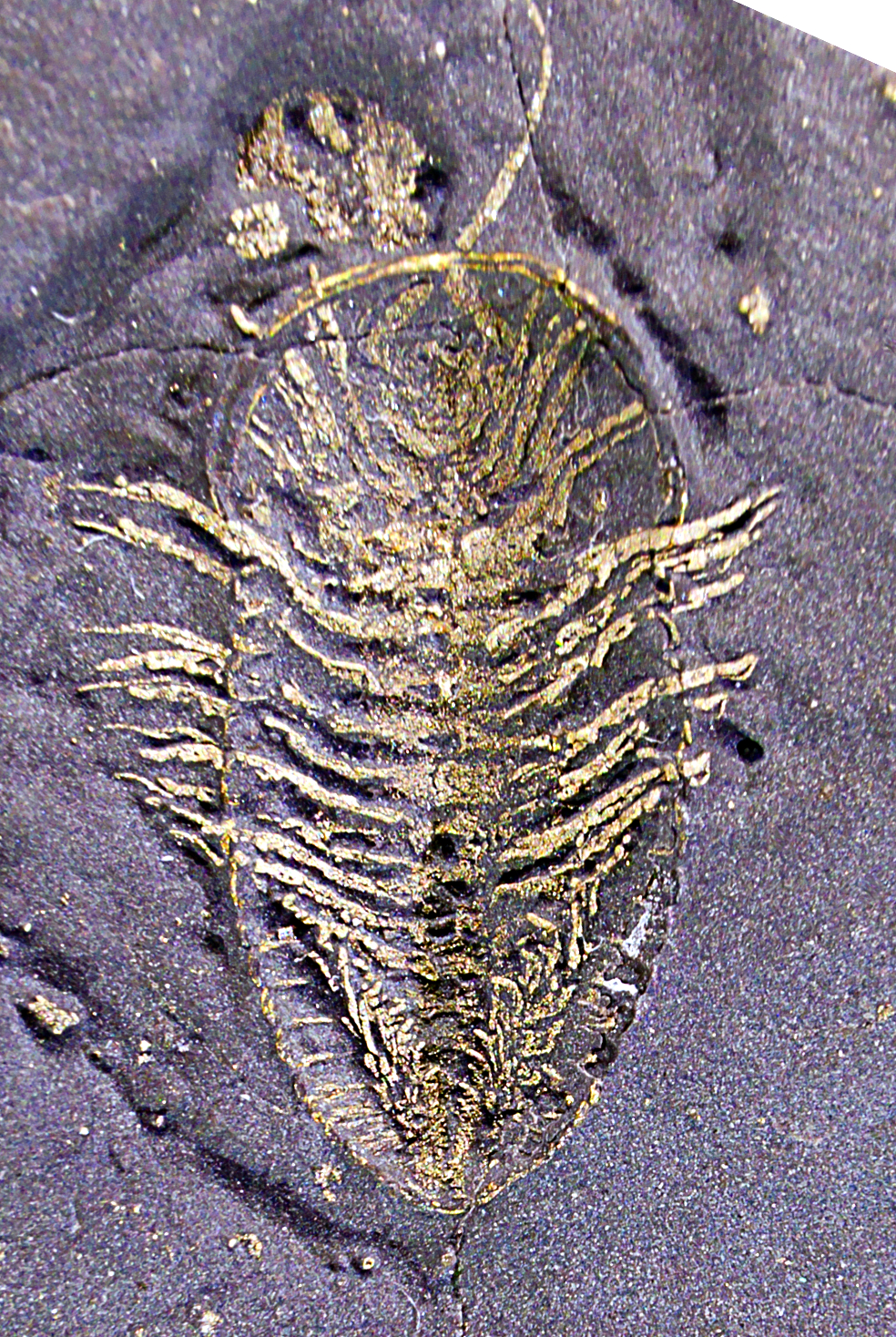|
Triarthrus
''Triarthrus'' is a genus of Upper Ordovician ptychopariid trilobite found in New York, Ohio, Kentucky, and Indiana, eastern and northern Canada, China and Scandinavia. It is the last of the Olenid trilobites, a group which flourished in the Cambrian period. The specimens of ''T. eatoni'' that are found in the Beecher's Trilobite Bed, Rome, New York area are exquisitely preserved showing soft body parts in iron pyrite. Pyrite preservation has given scientists a rare opportunity to examine the gills, walking legs, antennae, digestive systems, and eggs of trilobites, which are rarely preserved. ''Triarthrus'' is therefore commonly used in science texts to illustrate trilobite anatomy and physiology. Distribution * ''T. beckii'' Upper Caradoc and Ashgill, Snake Hill Formation, Cohoes, New York State; and Kentucky. * ''T. billingsi'' Ashgill?, Quebec * ''T. canadensis'' is known from the Upper Ordovician of Canada (Katian, lower Member of the Whitby Formation, Craigleith vicinity, ... [...More Info...] [...Related Items...] OR: [Wikipedia] [Google] [Baidu] |
Beecher's Trilobite Bed
Beecher's Trilobite Bed is a Konservat-Lagerstätte of Late Ordovician (Caradoc) age located within the Frankfort Shale in Cleveland's Glen, Oneida County, New York, USA.Martha Buck's senior thesis on the Beecher's Trilobite Bed Photos (and more) of trilobites from Beecher's Trilobite Bed from Yale Peabody Museum Only 3–4 centimeters thick, Beecher's Trilobite Bed has yielded numerous exceptionally preserved s with the ventral anatomy and ... [...More Info...] [...Related Items...] OR: [Wikipedia] [Google] [Baidu] |
Trilobite
Trilobites (; meaning "three-lobed entities") are extinction, extinct marine arthropods that form the class (biology), class Trilobita. One of the earliest groups of arthropods to appear in the fossil record, trilobites were among the most successful of all early animals, existing in oceans for almost 270million years, with over 22,000 species having been described. Because trilobites had wide diversity and an easily fossilized mineralised exoskeleton made of calcite, they left an extensive fossil record. The study of their fossils has facilitated important contributions to biostratigraphy, paleontology, evolution, evolutionary biology, and plate tectonics. Trilobites are placed within the clade Artiopoda, which includes many organisms that are morphologically similar to trilobites, but are largely unmineralised. The relationship of Artiopoda to other arthropods is uncertain. Trilobites evolved into many ecological niches; some moved over the seabed as predators, scavengers, or ... [...More Info...] [...Related Items...] OR: [Wikipedia] [Google] [Baidu] |
Suture (anatomy)
In anatomy, a suture is a fairly rigid joint between two or more hard elements of an organism, with or without significant overlap of the elements. Sutures are found in the skeletons or exoskeletons of a wide range of animals, in both invertebrates and vertebrates. Sutures are found in animals with hard parts from the Cambrian period to the present day. Sutures were and are formed by several different methods, and they exist between hard parts that are made from several different materials. Vertebrate skeletons The skeletons of vertebrate animals (fish, amphibians, reptiles, birds, and mammals) are made of bone, in which the main rigid ingredient is calcium phosphate. Cranial sutures The skulls of most vertebrates consist of sets of bony plates held together by cranial sutures. These sutures are held together mainly by Sharpey's fibers which grow from each bone into the adjoining one. Sutures in the ankles of land vertebrates In the type of crurotarsal ankle, which is fo ... [...More Info...] [...Related Items...] OR: [Wikipedia] [Google] [Baidu] |
The American Journal Of Science (1896) (17966037580) (cropped)
''The'' is a grammatical article in English, denoting nouns that are already or about to be mentioned, under discussion, implied or otherwise presumed familiar to listeners, readers, or speakers. It is the definite article in English. ''The'' is the most frequently used word in the English language; studies and analyses of texts have found it to account for seven percent of all printed English-language words. It is derived from gendered articles in Old English which combined in Middle English and now has a single form used with nouns of any gender. The word can be used with both singular and plural nouns, and with a noun that starts with any letter. This is different from many other languages, which have different forms of the definite article for different genders or numbers. Pronunciation In most dialects, "the" is pronounced as (with the voiced dental fricative followed by a schwa) when followed by a consonant sound, and as (homophone of the archaic pronoun ''thee' ... [...More Info...] [...Related Items...] OR: [Wikipedia] [Google] [Baidu] |
Marine Transgression
A marine transgression is a geologic event where sea level rises relative to the land and the shoreline moves toward higher ground, resulting in flooding. Transgressions can be caused by the land sinking or by the ocean basins filling with water or decreasing in capacity. Transgressions and regressions may be caused by tectonic events like orogenies, severe climate change such as ice ages or isostatic adjustments following removal of ice or sediment load. During the Cretaceous, seafloor spreading created a relatively shallow Atlantic basin at the expense of a deeper Pacific basin. That reduced the world's ocean basin capacity and caused a rise in sea level worldwide. As a result of the sea level rise, the oceans transgressed completely across the central portion of North America and created the Western Interior Seaway from the Gulf of Mexico to the Arctic Ocean. The opposite of transgression is regression where the sea level falls relative to the land and exposes the form ... [...More Info...] [...Related Items...] OR: [Wikipedia] [Google] [Baidu] |




